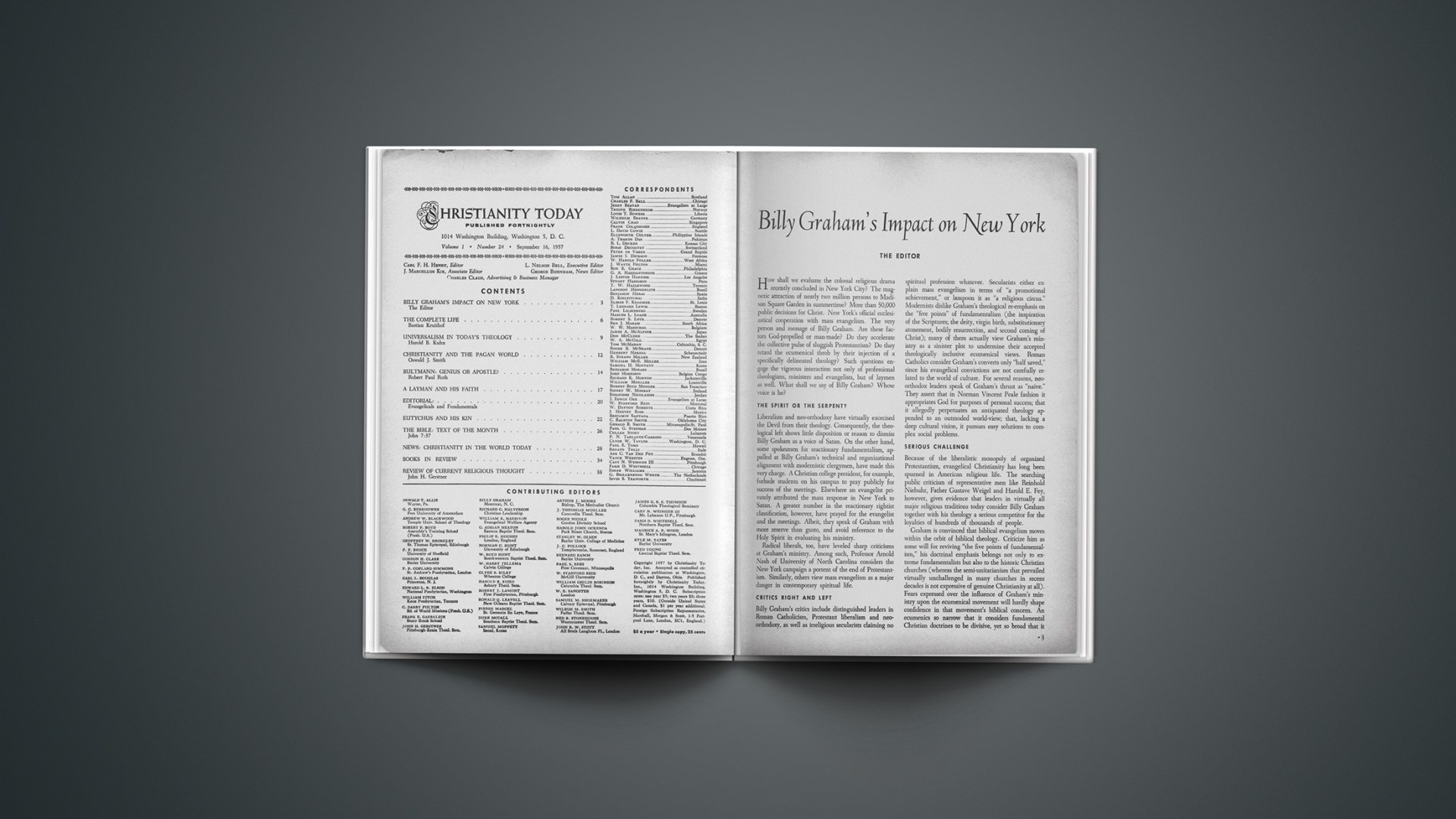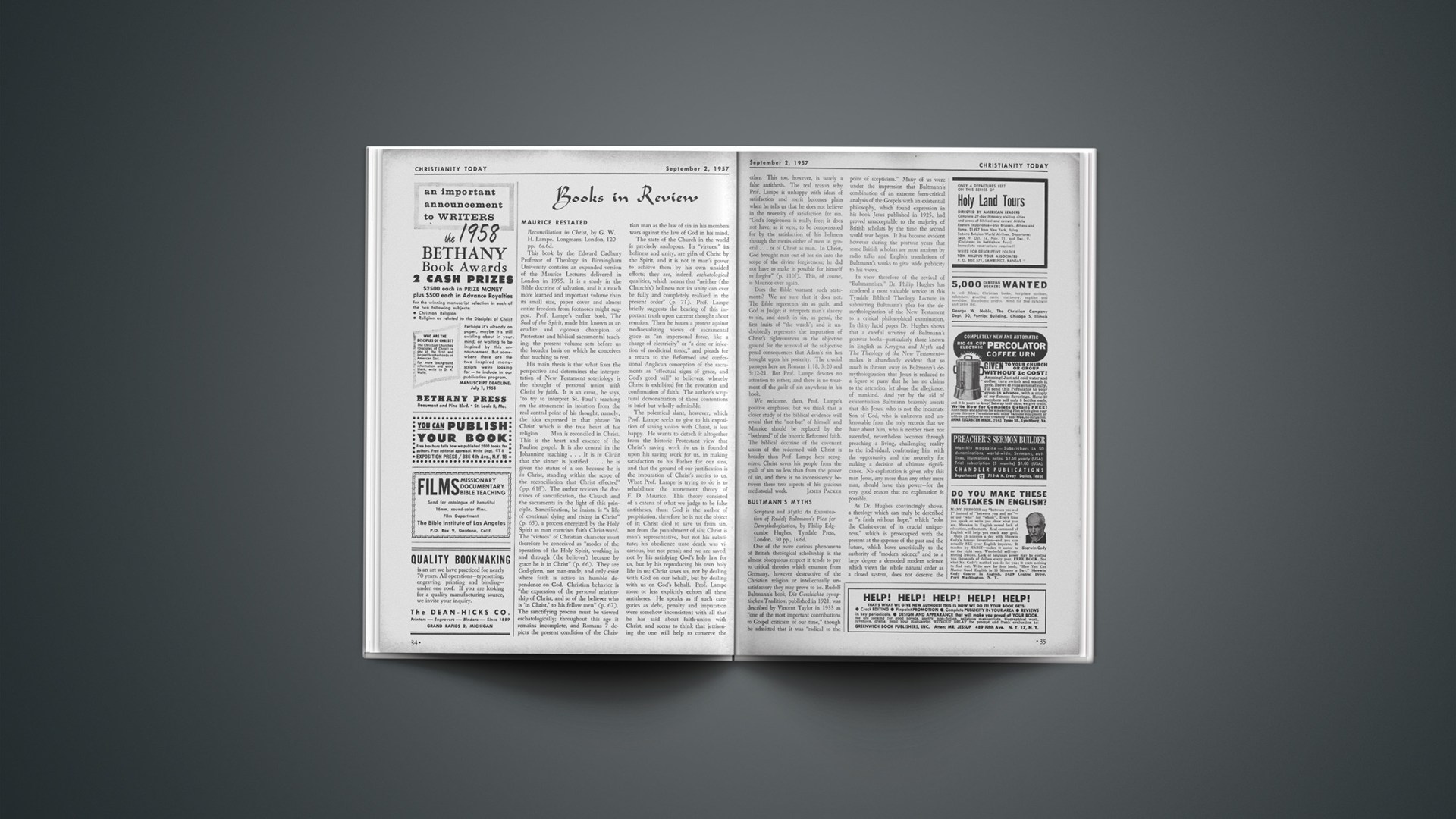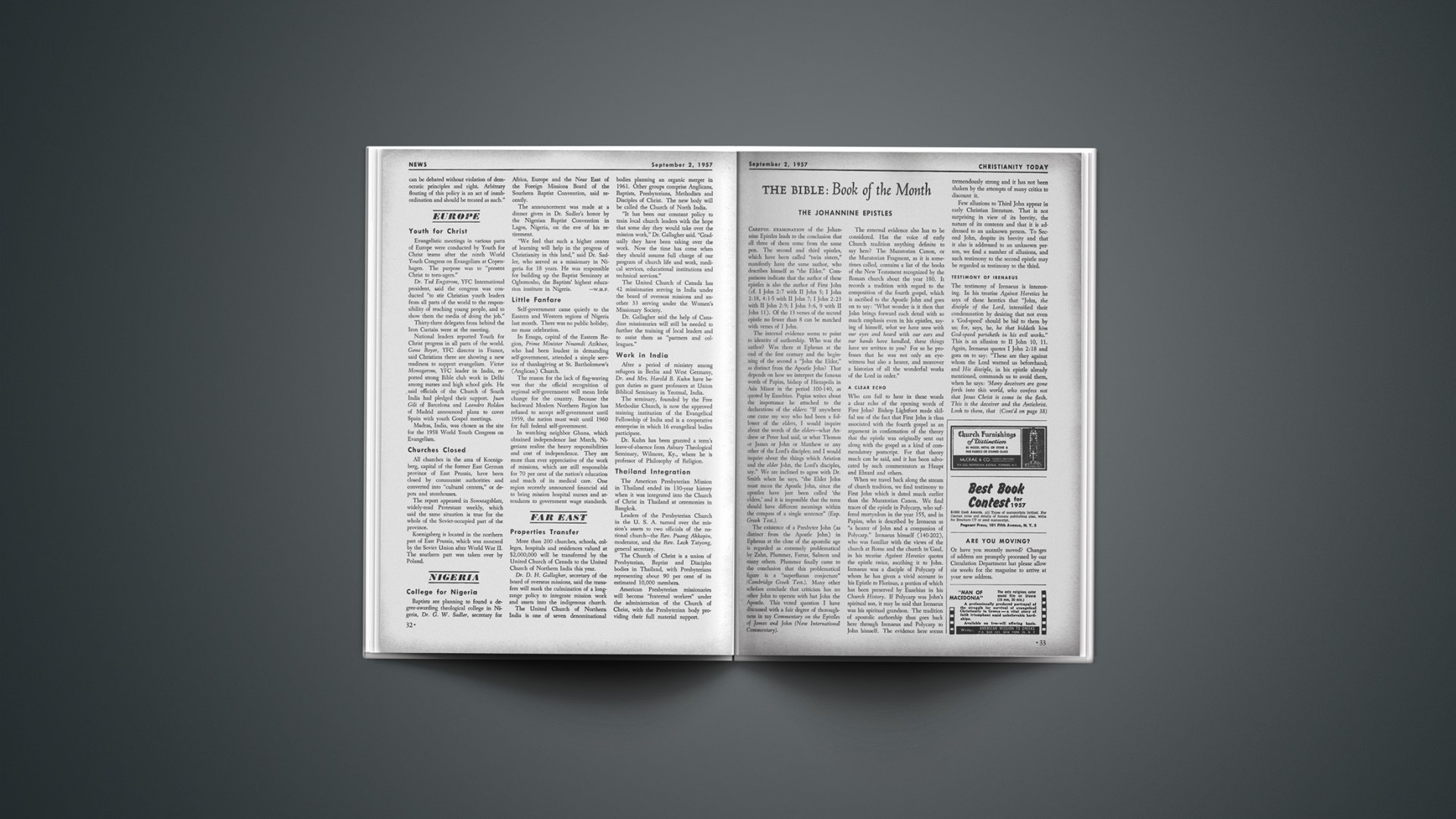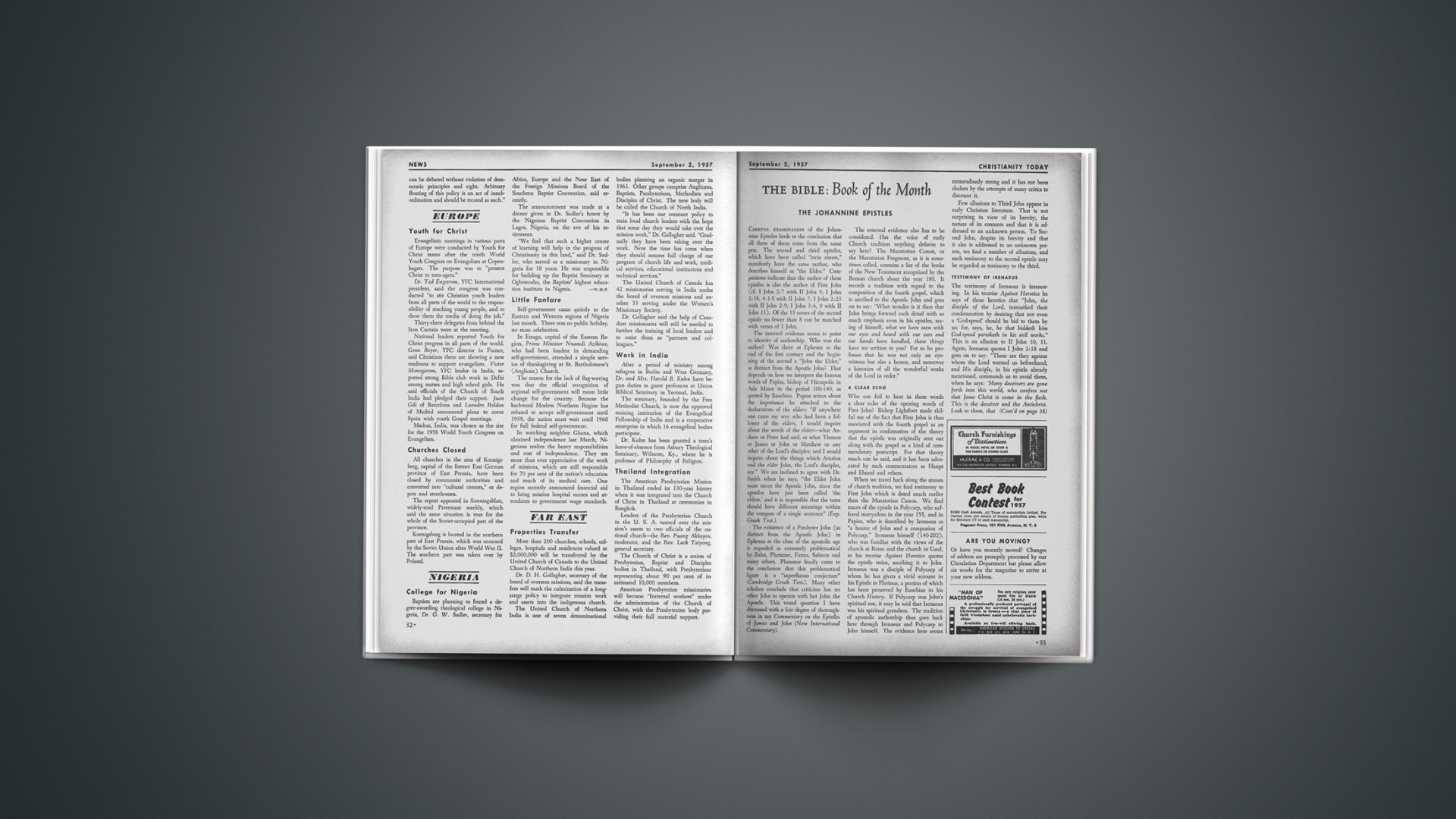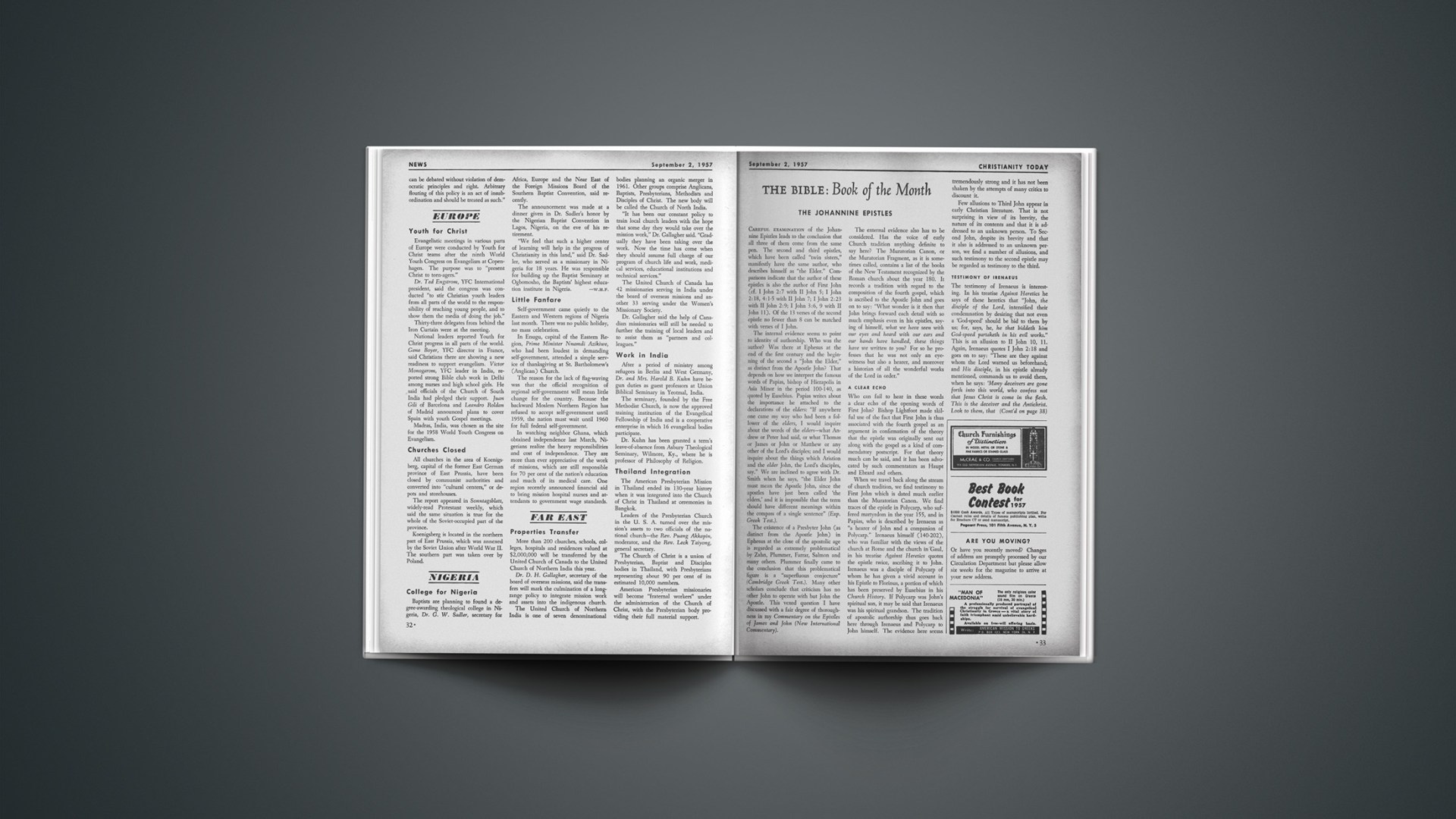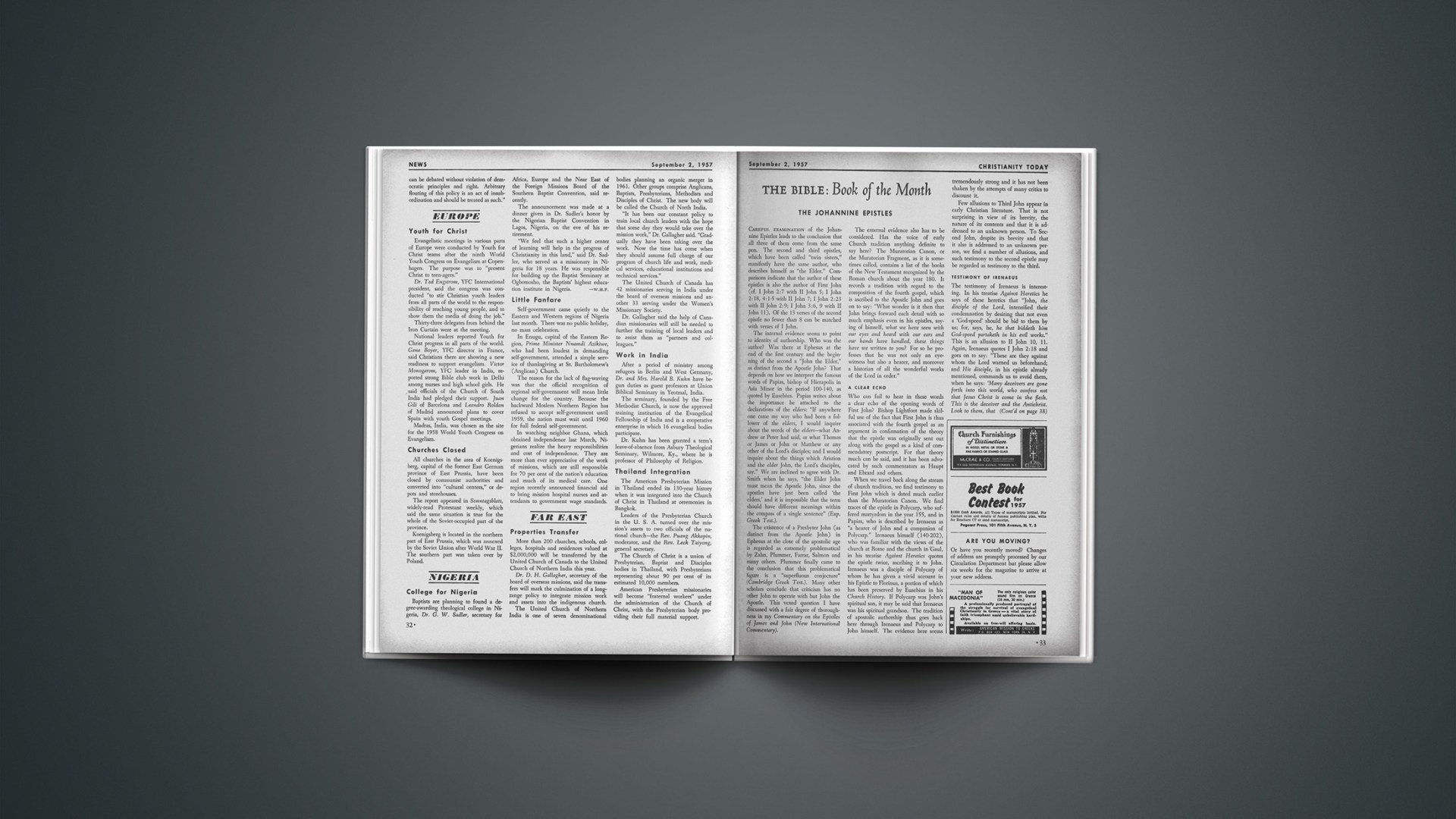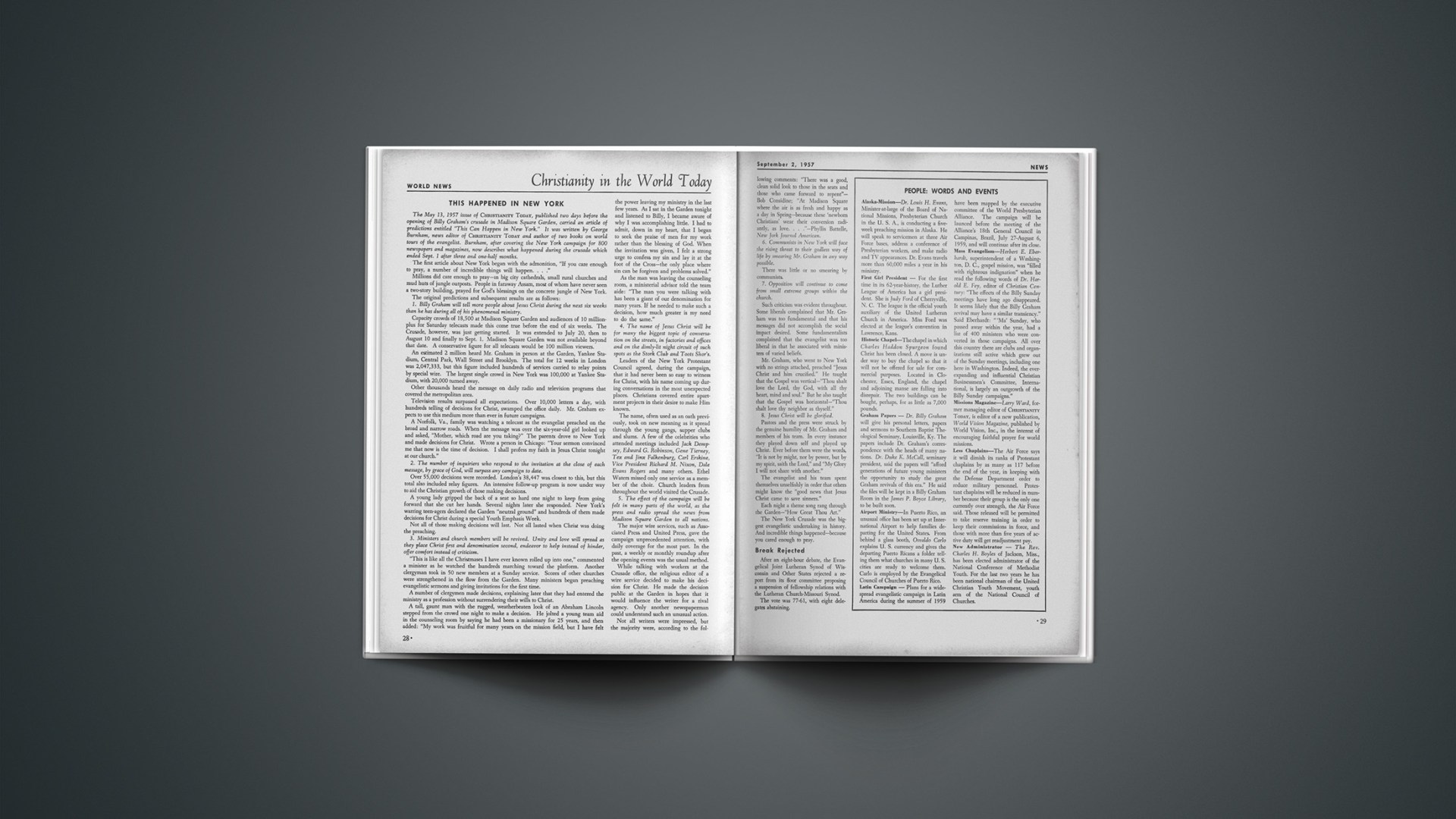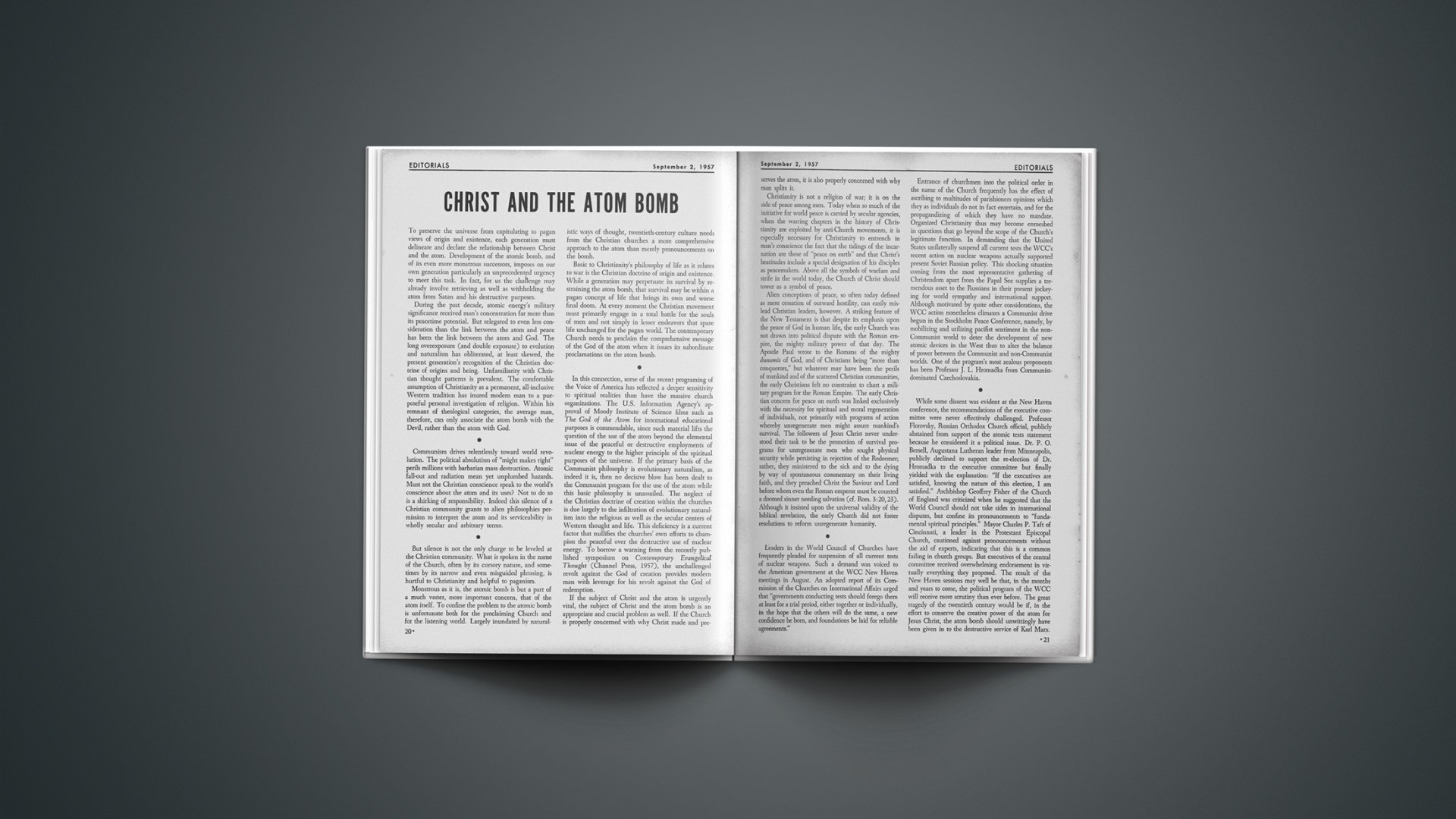How shall we evaluate the colossal religious drama recently concluded in New York City? The magnetic attraction of nearly two million persons to Madison Square Garden in summertime? More than 50,000 public decisions for Christ. New York’s official ecclesiastical cooperation with mass evangelism. The very person and message of Billy Graham. Are these factors God-propelled or man-made? Do they accelerate the collective pulse of sluggish Protestantism? Do they retard the ecumenical throb by their injection of a specifically delineated theology? Such questions engage the vigorous interaction not only of professional theologians, ministers and evangelists, but of laymen as well. What shall we say of Billy Graham? Whose voice is he?
The Spirit Or The Serpent?
Liberalism and neo-orthodoxy have virtually exorcised the Devil from their theology. Consequently, the theological left shows little disposition or reason to dismiss Billy Graham as a voice of Satan. On the other hand, some spokesmen for reactionary fundamentalism, appalled at Billy Graham’s technical and organizational alignment with modernistic clergymen, have made this very charge. A Christian college president, for example, forbade students on his campus to pray publicly for success of the meetings. Elsewhere an evangelist privately attributed the mass response in New York to Satan. A greater number in the reactionary rightist classification, however, have prayed for the evangelist and the meetings. Albeit, they speak of Graham with more reserve than gusto, and avoid reference to the Holy Spirit in evaluating his ministry.
Radical liberals, too, have leveled sharp criticisms at Graham’s ministry. Among such, Professor Arnold Nash of University of North Carolina considers the New York campaign a portent of the end of Protestantism. Similarly, others view mass evangelism as a major danger in contemporary spiritual life.
Critics Right And Left
Billy Graham’s critics include distinguished leaders in Roman Catholicism, Protestant liberalism and neo-orthodoxy, as well as irreligious secularists claiming no spiritual profession whatever. Secularists either explain mass evangelism in terms of “a promotional achievement,” or lampoon it as “a religious circus.” Modernists dislike Graham’s theological re-emphasis on the “five points” of fundamentalism (the inspiration of the Scriptures; the deity, virgin birth, substitutionary atonement, bodily resurrection, and second coming of Christ); many of them actually view Graham’s ministry as a sinister plot to undermine their accepted theologically inclusive ecumenical views. Roman Catholics consider Graham’s converts only “half saved,” since his evangelical convictions are not carefully related to the world of culture. For several reasons, neo-orthodox leaders speak of Graham’s thrust as “naive.” They assert that in Norman Vincent Peale fashion it appropriates God for purposes of personal success; that it allegedly perpetuates an antiquated theology appended to an outmoded world-view; that, lacking a deep cultural vision, it pursues easy solutions to complex social problems.
Serious Challenge
Because of the liberalistic monopoly of organized Protestantism, evangelical Christianity has long been spurned in American religious life. The searching public criticism of representative men like Reinhold Niebuhr, Father Gustave Weigel and Harold E. Fey, however, gives evidence that leaders in virtually all major religious traditions today consider Billy Graham together with his theology a serious competitor for the loyalties of hundreds of thousands of people.
Graham is convinced that biblical evangelism moves within the orbit of biblical theology. Criticize him as some will for reviving “the five points of fundamentalism,” his doctrinal emphasis belongs not only to extreme fundamentalists but also to the historic Christian churches (whereas the semi-unitarianism that prevailed virtually unchallenged in many churches in recent decades is not expressive of genuine Christianity at all). Fears expressed over the influence of Graham’s ministry upon the ecumenical movement will hardly shape confidence in that movement’s biblical concern. An ecumenics so narrow that it considers fundamental Christian doctrines to be divisive, yet so broad that it includes both Greek Orthodox and the most liberal churches, can hardly be expected to offer a return to Christ and the gospel.
Friends As Well As Foes
On the other hand, approval of Graham’s ministry is wider than sympathy for his theology. While some Protestant leaders attach little significance to doctrine of any kind, they interpret mass evangelism as a legitimate phase of the wider “return to religion” in contemporary American life. Others, actually apprehensive of Graham’s theology, nonetheless welcome his impact on the masses for its inevitable spur to church attendance, and even to reinforcement of membership with new recruits at a time of financially burdensome physical expansion. Still others, while in theological disagreement with Graham, feel that his evangelical supporters could enrich the ecumenical movement no less than liberal, neo-orthodox and conservative forces already within its framework have done. To some, Graham holds a strategic key to the ecumenical movement. To others, whatever theological difficulties may be involved for contemporary Protestantism, Graham’s ministry demonstrates the pragmatic success of his evangelistic message.
While proponents of Graham’s ministry fall into all these categories, his fullest support unquestionably comes from Protestant ministers personally convinced of the theological basis of his work. To them, Christian witness includes the ministry of mass evangelism, a ministry in which Billy Graham excels. Moreover, for them, biblical theology and biblical evangelism imply each other: the evangelistic challenge inevitably raises the theological question, while theology to be biblical must yield a missionary and evangelistic concern for lost masses in need of salvation.
A Pathetic Minority
New York City, to which Mr. Graham courageously carried a missionary investment that some of his friends feared might prove “a colossal bust,” is a metropolitan area of ten to fifteen million persons. Roman Catholics “claim” 75%, Protestants 33% of the population. But churches of all faiths reach less than half the population, and Protestantism is a pathetic minority.
Despite liberalism’s domination of Protestantism in New York for almost two generations, the movement made little impact upon the city’s unconverted masses. While the Protestant Council of New York had a department of evangelism from its beginning, interest in evangelism was at such a low ebb that the department had not been staffed. Yet more than four million inhabitants within the city limits belonged to no church, Protestant, Catholic or Jewish.
These facts must not be forgotten in weighing criticisms that Mr. Graham’s influence upon social institutions and the world of culture has been meager. Religious forces primarily dedicated to Christianizing the social order have little to show for many decades of effort. The long-established church agencies achieved no obvious turn in the dominant temper of New York life.
Indispensable Beginning
Over against the attempt of some to spawn a Christian culture through ethical reorganization of unregenerate humanity, Billy Graham summoned New York churches to their primary task of evangelizing lost multitudes for personal acceptance of Jesus Christ as Saviour and Lord. The requirement of individual repentance and faith in Jesus Christ as Saviour and Lord, neglected by the “social gospel,” gained new biblical centrality.
Much criticism of Mr. Graham’s ministry is directed against the social phase of his message. Does he sharpen the religious awareness of central moral problems in national life? Is he concerned to infuse justice into the social order? Does he seek the translation of personal commitment into great social institutions? In short, Mr. Graham is often charged with diluting and over-simplifying the requirements of Christian social ethics.
The question is pertinent whether the Church properly looks to the evangelist to delineate the intricacies of Christian social ethics, any more than the Church rightly expects proficiency in mass evangelism from the theologian. Much of the Niebuhr-Graham debate has overlooked the fact that the bulk of the Apostle Paul’s teaching on social ethics is hardly deducible from his sermonic ministry.
Optimism And Pessimism
Nor must we accept every current plea for Christian social ethics as framed in an acceptable evangelical way. Mr. Graham has so much stressed the new birth as the basic ingredient to a new social order that neo-orthodox thinkers charge him with ignoring the corruption of sin in regenerate experience, and therefore with reflecting the illusions of liberal Protestantism.
While the problems of Christian culture are no doubt somewhat more complex than Mr. Graham implies, perhaps under the necessities of an evangelistic thrust, to many observers the neo-orthodox approach seems needlessly overcomplicated; by shrouding the simplicities of the gospel with theological subtleties, neo-orthodoxy well nigh places the Christian faith beyond the reach of the man in the street. Indeed, the charge of naivete pressed against evangelical Christianity today by Bultmann, Tillich and Niebuhr is not in all respects modern; it reflects a line of attack made already by the Gnostics in early Christian ages, and is based in part upon disposition to question aspects of the theology of revelation. Unfortunately, Christianity has often become more concessive, the more highly intellectualized; in place of “uncritical bibliolatry” scholars readily yield the field to criticism of the Bible. Tumult over “the obscurantism of literalism” has a long echo and bespeaks an eagerness to reject as antiquated vital elements of the Christian world-life view.
If Mr. Graham’s approach to the social question is too optimistic, the neo-orthodox approach may be too pessimistic. Neo-orthodoxy suffers from viewing man as sinner simply on the grounds of his creatureliness, i.e., on the basis of original creation. Its despair of social progress reflected in Karl Barth’s earlier writings is often criticized. While orthodox evangelism may underestimate the difficulties of social progress within the framework of redemption, neo-orthodox ethics underestimates the power of the Spirit in collective life. Whereas in the last generation liberalism dismissed the evangelical view as pessimistic, an ironic twist of twentieth-century theology is evangelicalism’s discovery of unjustifiable despair in the theology of neo-orthodoxy.
The Social Vision
To charge Billy Graham with deficient social vision is less than fair. He underscores the need to reflect Christian ideals in family, in business and labor, and in political relations.
Graham offered no direct reply to Niebuhr’s proposal that the genuineness of personal regeneration be demonstrated by applying the commandment of “love for neighbor” especially to the contemporary vice of race prejudice, thus sharpening the religious conscience at the very point where secular agencies are most indignant over social evil. But he replied indirectly (Life Magazine, Oct. 1, 1956), that such a test would tend to narrow the dimensions of neighbor-love. (Niebuhr was rightly concerned because the trade union movement supported the Supreme Court decision more aggressively than the churches; Graham might properly have noted the long-standing trade union tolerance of another type of exploitation involving all races within its ranks.) Total repentance seemed a far more complex matter.
In actuality, Graham emphasizes regeneration and sanctification, more than a broad program of social action, as the key to the problem of race hatred. The campaign in New York, where there are more colored than white Protestants, was wholly integrated. Negro and white Christians shared alike in the choir, in ushering and in counseling. Ethel Waters, Negro radio and television star, was a featured outside soloist. For thousands of Christians it was a new experience to share a hymnbook in worship with a member of another race. From Madison Square Garden, quite unpublicized, rose outlines of a new working relationship between believers of all races. Gain was registered, therefore, in the very realm that most concerned some of Mr. Graham’s critics.
At the conclusion of the Garden campaign, the Rev. Dan Potter, executive director of the Protestant Council of New York, told a news conference that he did not know another clergyman in the city who had spoken as forcibly from the pulpit as Billy Graham during the Crusade on areas of Christian social responsibility.
Depth Of Penetration
Depth of social penetration remains nonetheless an important question. Idealistic short cuts have stranded modern life in the swamps of secularism near the jungles of naturalism. All social agencies today acknowledge the difficulty of moral penetration in big cities. Because of the structure of modern community life, the sense of social solidarity is all but gone. While many workers live in city tenement and slum districts, the upper classes usually only work in the cities while they reside in the suburbs. Here in these suburban communities residents are thrown together mainly for purposes of self-preservation and self-aggrandizement. In earlier generations community interests ran deeper; today, community existence poses major obstacles to a decisive turn in social outlook and life.
Moreover, the influence of evangelism upon the social order—marriage and the home, labor and economics, the state and culture—cannot be measured overnight. (Few of Mr. Graham’s critics would want their localized ministries evaluated hastily.) The striking response of young people to Graham’s plea for Christian commitment in the face of New York’s juvenile delinquency problem, and the response of college students as well, both involve strong future significance. While New York still faces the delinquency problem on a large scale, Graham’s special plea to teen-agers gained a dramatic response after police authorities had tried virtually everything else without success. During youth week in the Garden teen-agers comprised 60% of the capacity crowds. Decisions were more numerous than during earlier weeks of the campaign. More than half the converts were teen-agers, mostly unchurched. Some admittedly had participated in gang wars. Garden statistics also indicate that 2000 students from more than 400 colleges registered decisions. For these young lives strategic problems of Christian vocation and life still remain, but they represent evangelical resources with which the Church can hopefully face the coming generation.
In evaluating social impact, however, the question of present-day achievement inevitably pushes to the fore. Those who stress social issues ask: what centers of sin have shut down? what changes have taken place in the ethics of business and labor? what spheres of culture and art have been penetrated by Christian claims? what discernible impact has been made upon the problem of divorce and in the realm of sex? One critic has lashed Graham on the ground that “he failed to make enemies—enemies of the politicians at Tammany Hall, the publishers of filth magazines, the liquor traffic, the labor racketeers, and many of the fellows in the front pews of our churches who can continue their sinful practices of deceit and thievery …” What shall we say to these things?
The Gospel And Reform
It is tempting to reply that none of the great evangelists has been a social reformer in the direct sense. Cultural reformers have arisen, however, under their inspiration and impetus, as Wilberforce, for example, followed Wesley, to eliminate the slave trade in England. Those who would capture the realms of culture for Christ must first follow Mr. Graham’s initial penetration, for the spheres of marriage and the home, labor and economics, politics and government, education and culture largely remain in the grip of secularism today.
Some critics argue that Graham’s ministry has not successfully “broken through” to the unchurched. It might be asked, what Christian spokesmen achieve a conspicuous breakthrough today? And who has tried more than Graham? When in the history of this century has New York City witnessed a more sustained evangelistic attempt? If there is no general revival of historic Christianity, is this Graham’s fault? Those who speak of the disproportion between the magnitude and success of Graham’s campaigns when measured in lasting converts and religious and moral concern in the social sphere, easily forget that almost every local church program must wrestle with the same difficulties.
The fact is, however, that Graham has achieved a partial penetration, however fractional. Surely Graham’s ministry has lifted Christian evangelism into a prominent and respectable place in the national news. During the last generation it was a rare achievement when, through some evangelistic impact, Christian commitment was made an easy subject of conversation. Graham’s ministry has created a climate of evangelical witness in England, Scotland and the United States. In this Communist era how many spiritual leaders have done more to allay Christian “lost cause” jitters? Graham has gained national interest for the gospel on television (the Garden telecasts attracted letters from 100,000 seekers), competing against featured Saturday night entertainment programs. The late telecast of Impact reached many a barroom crowd. In the heart of pagan New York, Madison Square Garden and the gospel were made so synonymous that the Christian witness was given an initiative which 1700 participating churches will be able to exploit for months to come. Hundreds of thousands who missed the Garden meetings will admit privately to their probable loss of spiritual blessing. For years the “worldly crowd,” whenever it returns to the Garden for a sports event, will recall Billy Graham’s call for decisions; will hear Beverly Shea singing “How Great Thou Art”; will see hundreds of converts grouped at the altar. For a generation to come, those who shared the blessings of the Garden will be telling their children and their children’s children.
The Problem Of The Home
In repairing unhappy marriages and broken homes the New York campaign achieved spectacular results, especially in its television ministry. Suicides were averted; clandestine sex appointments interrupted; separated mates restored; dead marriages revived. The conversion of marital partners was a nightly spectacle of the campaign.
Admittedly there are few signs that Graham’s meetings significantly affected the worlds of business and labor. These spheres are vast machines today. One can scarcely say that many who control their destinies were enlisted for Christ. The campaign did reach the comfortable middle class, as one could tell from its nightly dress; the extreme poor and the rich were seldom present. Large blocs of workers from the garment industry attended through the encouragement of their leaders, which was all to the good, although Graham’s ministry is pointed toward personal decision without elaborating the world of daily work as a realm for the service of God and one’s fellow man. The New York committee drew to itself some men of towering influence in the world of finance, and committee members did not hestitate to describe the experience as a time of personal spiritual growth and gain. New campaign decisions at the executive level were not numerous, though there were some. Graham’s meeting on Wall Street had a profound momentary effect upon influential men; how good or ready the soil was it is too early to tell. The cost of the Garden campaign was $1,500,00 ($650,000 additional for television), a budget that could not have been met without substantial gifts from dedicated wealthy sources. Liberal churchmen often ask what evident changes have come into the prevailing climate of business ethics? This type of question has often harbored an anticapitalistic edge. But even when it has not, and probes rather for a healthy correlation of free enterprise and Christian principles, the inquiry too often looks to resolutions, organization and legislation, rather than to personal regeneration as the real key to social change.
In the sphere of culture and the arts the campaign shaped the Christian Arts Fellowship, after 400 seekers from the entertainment field responded at the Garden. Jerome Hines (Caruso Award winner) of the Metropolitan Opera company is first president. The group enlists twice-born talent in the entertainment world of television, radio, theater and stage (including playwrights, producers, actors, musicians, singers and models). While its main drive is personal religion and soul-winning (most affiliates are babes in Christ), with the aim of changing men, some revision of the theatrical world could issue from its concern for an enlarged evangelical witness.
Back To The Gospel
In surveying the campaign from the foregoing perspectives, however, one inevitably returns to the basic principle that the major Graham thrust is personal. The social complex is viewed, quite in accord with biblical theology, as a reflex of the realm of spiritual decision. Graham’s mission is that of an evangelist, not that of a social reformer, though he is convinced that biblical evangelism is the best road to social reform.
This emphasis, moreover, introduced into inter-church Christianity in New York City the deepest bond in its history of ecumenical enthusiasm. “There has been more real fellowship among ministers and churches in New York City than at any time for 25 years,” said one leader. Another put it this way: “The Church is most ecumenical when it is most evangelical.”
Madison Square Garden may not tower far enough, but it laid strong foundations. One reason to think that the social force of Graham’s converts can be preserved is his emphasis that Christian growth is more than a private affair; it requires fellowship in a church where Christ is proclaimed as Saviour and Lord. The real problem, therefore, is whether the churches will channel these converts into constructive action without sacrificing either evangelistic priority or social vitality. The conservation or non-conservation of converts will reflect the virility of the churches to which Billy Graham has entrusted them. Whatever may be said about the task that remains, the New York sponsoring committee is confident not only that the campaign was “the most prayed for crusade in history,” but also that in Madison Square Garden “the tide came in.”
END

